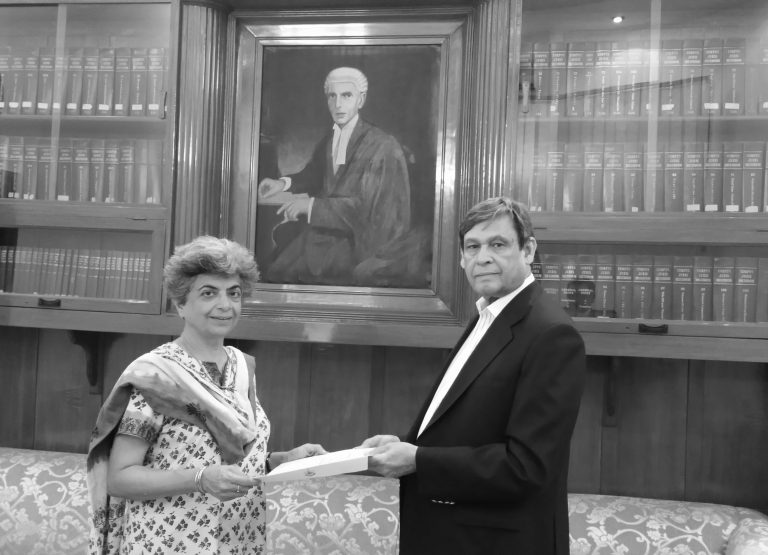
A piece of Amil history from Jyoti Punwani, who visited Karachi as part of a Mumbai Press Club delegation on the invitation of the Karachi Press Club, in Dec 2013.
It takes a miracle to get me to smile for a photograph. Friends have had to crack jokes, cajole, and finally given up. Well, the miracle happened in Karachi.
When I was in school in the 1960s, everyone in Mumbai had a ‘gaon’, a ‘native place’ to which they went during the holidays. I often asked my mother: “Where’s our gaon?” “Bombay’s your gaon,” she would answer with a laugh, leaving me dissatisfied. In my heart, I knew, my gaon was Sindh. Those streets of Hyderabad where the vendors sold jaamuns with the cry: “jammu vechaara, kaara hi kaara – jamun, poor fellow, as black as can be”; the lanes of Karachi where my mother would take boys double seat on her cycle to college. Her memories made me yearn to see those places. It became an obsession for me to visit Sindh.
Ever since my name appeared on the list of journalists going to Pakistan with the Mumbai Press Club, one fear haunted me – would I be able to find my mother’s home in Karachi? Just when I had given up, I found a friend of my mother who had lived opposite her house. “It was Amil Colony No2, Kitchlu Road. The names must have changed,” Indra Aunty told me. Amazing for a woman in her eighties, she gave me exact directions: “Get off at the bus stop after Guru Mandir, walk ahead, cross the road, go into a small lane, turn left, then right, there will be a cement house on the corner, and the second or third house will be your mother’s. It’s at a height.”
When I reached Karachi, I had the opportunity to visit the area three times, once with my niece Humaira Rahman. Following Indra Aunty’s directions, I landed at the spot. The house was no longer standing, but I could imagine my mother there, picture the gatherings held there by my aunt, Kamala Hiranand, INC worker and corporator in 1946, and uncle, Hiranand Karamchand, editor of Hindustan, a Sindhi newspaper.
It wasn’t just Kitchlu Road that was special for me. Karachi held many places I just had to see. The infinitely patient Aslam Khwaja, city chronicler, took me to DJ Science College and we barged into the office of the principal. Mumbai’s Sindhis know it as DJ Sind College, and it’s the alma mater of most Sindhi Amils, including my mother. With not a word of disapproval for having come without an appointment, Principal Balouch took us on a tour of the magnificent building, the library with its old desk and finally the arts section. A class was on; I could picture my mother seated there.
Across the road was the Sindh Muslim Law College, once the SC Shahani Law College, from where my father, Vishnu ‘Kan’ Punwani had graduated. I had wanted to see the classrooms; I ended up getting my father’s admission forms, thanks to Principal Hashmi.
Principal Hashmi’s account of his family’s migration left me ashamed, not just at the conduct of my countrymen in 1947, but also because I hadn’t wanted to make anyone cry. The principal’s father had been hacked to pieces; he could have shown me the door for having come, blithely unannounced, to see my father’s college. Instead, he instructed his staff to find my father’s admission form though I didn’t even know the year he had joined the college. The staff members, unfamiliar with the Hindu names that dominated the admission register, were still searching when we returned from our tour of the college. I started going through the register. It was like a roll call of the Sindhi community in Mumbai. I was wishing I had all day to go through it when a page turned and there it was. I had found it! Such was Principal Hashmi’s generosity that he made his staff find the second year’s form too, had both photocopied and placed in an envelope with my father’s name printed on it. As he handed the envelope over to me formally, I smiled for the photograph. I couldn’t help it.
Another miracle happened in Karachi. For the first time, I felt completely at ease being a Sindhi. It wasn’t easy growing up as one in Mumbai – looked on as refugees, we didn’t have the best of reputations. I could never identify with my community, and quickly lost myself in Mumbai’s cosmopolitan anonymity. When I landed in Karachi, I started speaking in Sindhi as a lark, and somewhat self-consciously; by the time I left, it had become second nature. I’ve never spoken as much Sindhi as I did in the five days I spent in Karachi. Listening to the jokes and comments of the Sindhi journalists who greeted me like a long lost sister (and showered me with gifts – including hand-made quilts – when I left, even packing them for me), made me feel I was back home, surrounded by the protective extended family with whom I’d grown up. I’d finally come to my gaon.
_______________________
(Excerpted from The Amils of Sindh by Saaz Aggarwal, black-and-white fountain (2019)
(First appeared in The News 12 Dec 2013)
Courtesy: Saaz Aggarwal /Sindh Stories
 Saaz Aggarwal is an independent researcher, writer and artist based in Pune, India. Her body of writing includes biographies, translations, critical reviews and humour columns. Her books are in university libraries around the world, and much of her research contribution in the field of Sindh studies is easily accessible online. Her 2012 Sindh: Stories from a Vanished Homeland is an acknowledged classic. With an MSc from Mumbai University in 1982, Saaz taught undergraduate Mathematics at Ruparel College, Mumbai, for three years. After a career break when she had a baby, during which time she established a by-line as a humour writer, she was appointed features editor at Times of India, Mumbai, in 1989, where she launched Ascent, the highly successful HR pullout of the Times of India Group. From 1998 to 2006, she was HR and Quality Head of Seacom, an Information Technology company based in Pune. As an artist, she is recognized for her Bombay Clichés, quirky depictions of urban India in a traditional Indian folk style, as well as a unique range of offerings at the annual Art Mandai event in Pune. Her art incorporates a range of media and, like her columns, showcases the incongruities of daily life in India.
Saaz Aggarwal is an independent researcher, writer and artist based in Pune, India. Her body of writing includes biographies, translations, critical reviews and humour columns. Her books are in university libraries around the world, and much of her research contribution in the field of Sindh studies is easily accessible online. Her 2012 Sindh: Stories from a Vanished Homeland is an acknowledged classic. With an MSc from Mumbai University in 1982, Saaz taught undergraduate Mathematics at Ruparel College, Mumbai, for three years. After a career break when she had a baby, during which time she established a by-line as a humour writer, she was appointed features editor at Times of India, Mumbai, in 1989, where she launched Ascent, the highly successful HR pullout of the Times of India Group. From 1998 to 2006, she was HR and Quality Head of Seacom, an Information Technology company based in Pune. As an artist, she is recognized for her Bombay Clichés, quirky depictions of urban India in a traditional Indian folk style, as well as a unique range of offerings at the annual Art Mandai event in Pune. Her art incorporates a range of media and, like her columns, showcases the incongruities of daily life in India.